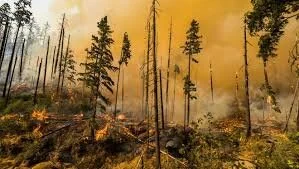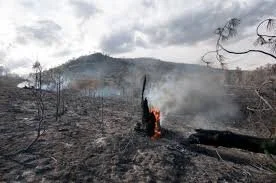Major Fires Pose Cyclical Threat; Researcher Calls for Sustainable Practices
By Haley Mast
Wildfires are a part of nature; they play a key role in shaping ecosystems by serving as an agent of renewal and change.
But the fires we are currently seeing burning in Oregon shouldn’t be reaching their current size and severity, according to a wildfire management student researcher Sima Safavi-Bayat.
Fires requiring heavy machinery such as jets, helicopters, and bulldozers make it clear that sustainable, preventative measures have not been undertaken.
Sima Safavi-Bayat smiling under the moon in Jackson , WY.
Fires in healthy forests, generally, burn closer to the forest floor and don’t make it to the canopy, where it becomes volatile.
Safavi-Bayat is a recent PSU graduate with her BS in Environmental Science with a focus on Forest and Landscape Ecology. She has been a part of a snow-hydrology and wildfire-management research projects with PSU.
Columbia Community Connection spoke with her on Friday, Sept. 11, 2020.
Why are the Fires so large?
Safavi-Bayat said wildfires that have recently emerged could have been prevented from growing as large.
There is no question that climate plays a role in the increase of wildfires, but there are other factors that are equally important in the cause of these events.
Many areas in the western US are currently being ravaged by record-setting wildfires for the second year in a row. The National Oceanic and Atmospheric Administration (NOAA) reports that in California, 14 out of the 20 largest wildfires on record have occurred over the past 5 years, and Oregon could likely face the same inclined threat.
Vicious Cycle
Safavi-Bayat discussed the vicious cycle climate change plays in its occurrence with wildfires. She said that the carbon dioxide (CO2) emissions that are released into the atmosphere during a wildfire are creating a positive feedback loop, where the added CO2 emission from a big burn warm the climate making the conditions more viable for another wildfire to start.
Early Snowmelt
Safavi-Bayat split boarding to the location where snow samples were collected in Jackson, WY.
In addition, she said resources are also depleted and altered by wildfires. During her snow hydrology research they concluded that snow albedo - the reflection of light from the snow - was reduced in burn sites, which in turn resulted in increased snowmelt rates. These increased snowmelt rates can be found to lower water supplies that cause dryer conditions earlier and trigger more fires. Safavi-Bayat had also said the chemical composition transfer to the snow from the burned debris is aiding in the pollution of Oregon’s waterways.
Fire Can Be Beneficial
Under normal conditions, wildfires are beneficial to the environment. Fires often remove alien plants that compete with native species for nutrients and space, and remove undergrowth, which allows sunlight to reach the forest floor, thereby supporting the growth of native species.
“Fires are welcomed (in a healthy biodiverse area), they will happen, and they should, ”Safavi-Bayat said.
What can be done?
Safavi-Bayat said policy changes could prevent the immense loss and uncertainty that fires are causing now. She explained the main focus should be “funding in the right areas,” and from a sustainable, economic standpoint, we would significantly reduce cost if we put more of our funding into preventative policies. She suggested reducing the density of trees on commercial timber producing acreage as well as maintaining biodiversity within those lands.
“Fire suppression is basically saying to nature, as most humans have, whatever we will ignore your cycles and let these stands grow denser and denser....changing areas that would have maybe only experienced low to mid-severity fires, manageable, predictable, to super unpredictable high-severity fires that exist mostly in the crown. When fires get to the crown, man, one pick up of wind and - boom - it's onto the next crown maybe a half a mile away where mostly only helicopters can reach,” she said.




